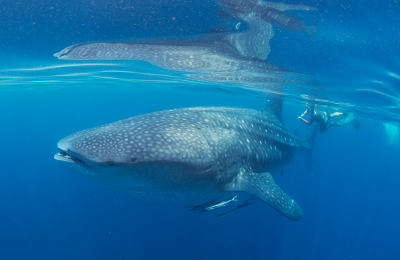Using AI to control energy for indoor agriculture
30 September 2024
Published online 15 August 2016
Whale shark populations in the Gulf are largely male and have novel heat-coping mechanisms.

The researchers conducted field work with ‘Sharkwatch Arabia’ to study the whale shark (Rhincodon typus), the largest known fish considered to be endangered worldwide. The study provides the first specific knowledge of the population ecology of mature whale sharks in the region and shows that they are still vulnerable to fishing and ship propellers.
“This study provides the first baseline information, providing an overview as well as a population assessment that future projects can compare against,” says lead author David Robinson, from the Heriot-Watt University, United Kingdom and Sharkwatch Arabia, United Arab Emirates.
This will allow researchers to see the fluctuation of the size of whale shark populations, and to monitor any changes in their movements, he adds.
The scientists identified more than 340 individual whale sharks at Al Shaheen by photographing each animal’s unique spot pattern, usually located on the flank area behind the fifth gill slit and above the pectoral fin. Aggregations of sharks were encountered from April to October. Their size ranged from 4 to 10m.
Al Shaheen, located 90 km off the Qatar coast, is a significant area where the sharks feed on tuna spawns.
In the Indian Ocean, the scientists identified two pregnant females for the first time. But at Al Shaheen, the majority of the whale sharks are mature male individuals.
Their feeding behavior was interesting, the scientists say; they were seen to feed for extended periods in the surface waters of Al Shaheen, where surface temperatures frequently exceed 35 °C during the hottest months. This means that they have developed a heat-coping mechanism, that the scientists say may provide insights into their long-term response to a warming ocean climate.
The whale sharks are likely to experience the world’s warmest seawater temperatures within the Arabian Gulf.
Besides fieldwork by the researchers, divers and seafaring personnel of Sharkwatch Arabia’ reported their encounters with 81 individual whale sharks outside Al Shaheen. “Thirteen individual sharks were re-sighted at different locations from those at which they were first seen, confirming that the sharks move between the Arabian Gulf and Gulf of Oman over inter-annual timescales,” the researchers say.
Michael Berumen, a marine scientist at the King Abdullah University of Science and Technology, Saudi Arabia says, that “understanding the structure of a given population such as the Arabian Gulf population gives us important insights to help us unravel mysteries like where female whale sharks give birth to their young.”
However, it will take many more years of research to understand the migration patterns that potentially connect regional populations, Berumen adds.
Experts are also concerned about the fate of whale sharks. “Although international whale shark trade is regulated through the species’ listing on the Convention on International Trade in Endangered Species (CITES), more conservation works are needed to protect whale sharks at a national level,” says Simon Pierce, a whale shark researcher at the Marine Megafauna Research Centre, Mozambique.
doi:10.1038/nmiddleeast.2016.125
Stay connected: